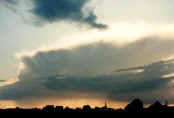
SkyStef's weather page
|
|
SkyStef's weather page |
Weather picture of the month October 2008
|
| Picture taken at Kampenhout on September 21 2008 at 1503 hours CET. |
| Cirriform cloudiness produces all kind of halo's. The most
common is the 22° radius halo and when the sun makes a low angle in many
cases with sundogs
or 22° parhelia (See
WPOM Sept. 2008). Less common is the white
parhelic
circle and when present, often only a part of it is visible. In this
circle, relative far from the sun, brighter spots or so called
120° parhelia may show
up. They occur 120° to the right and/or the left of the sun and are
relatively rare optic features. Due to the large distance from the sun, they
can be easy confused with thicker patches of Cirrus. But a closer (and more
time consuming) inspection of the sky can reveal if this is a real or false
halo. Although the infrequent halo's are usually difficult to find, always
be a alert when the more common one's show up. The picture shows part of a faint parhelic circle with a bright spot (left-middle part of picture), which was a 120° parhelion left of the sun. I was alerted by the fact that a couple of hours earlier a bright part of the parhelic circle was visible, but without bright spots. So afterwards the reward came along. |